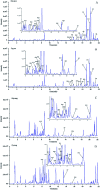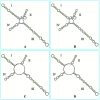Chemical and genetic discrimination of commercial Guangchenpi (Citrus reticulata 'Chachi') by using UPLC-QTOF-MS/MS based metabolomics and DNA barcoding approaches
- PMID: 35514483
- PMCID: PMC9067315
- DOI: 10.1039/c9ra03740c
Chemical and genetic discrimination of commercial Guangchenpi (Citrus reticulata 'Chachi') by using UPLC-QTOF-MS/MS based metabolomics and DNA barcoding approaches
Abstract
CRP (Citri Reticulatae Pericarpium), a famous traditional Chinese medicine, has also been extensively used in foods and condiments in dietary practice for centuries. According to the Chinese Pharmacopeia (2015 edition) it contains two subtypes, Guangchenpi (GCP) and Chenpi (CP). GCP exclusively originates from the pericarp of Citrus reticulata 'Chachi' cultivar and it's generally believed that GCP has superior qualities compared with the other main cultivars (CP). In the present study, an integrated approach combining LC-QTOF MS-based untargeted metabolomics analysis and DNA barcoding molecular identification was conducted to study the genetic diversity and chemical differences between GCP and CP. A validated UPLC-QTOF MS metabolomics method was established to identify markers by using PCA and OPLS-DA models. 34 identified metabolites could be used as chemical markers to distinguish effectively between the two subtypes. Among them polymethoxyflavones (PMF) such as hexamethoxyflavone (nobiletin and natsudaidain), pentamethoxyflavone (tangeretin and sinensetin), and tetramethoxyflavone are the most influential markers. Support vector machines were employed to classify all the samples and these markers showed good prediction accuracy (100%). The results of DNA barcoding showed that the secondary structure of the ITS2 sequences were significantly different among GCP and other three cultivars. The study indicated the integrated method could be a powerful and reliable analytical tool for differentiating GCP from CP.
This journal is © The Royal Society of Chemistry.
Conflict of interest statement
There are no conflicts to declare.
Figures







Similar articles
-
Cultivar differentiation of Citri Reticulatae Pericarpium by a combination of hierarchical three-step filtering metabolomics analysis, DNA barcoding and electronic nose.Anal Chim Acta. 2019 May 16;1056:62-69. doi: 10.1016/j.aca.2019.01.004. Epub 2019 Jan 8. Anal Chim Acta. 2019. PMID: 30797461
-
Discrimination of Citrus reticulata Blanco and Citrus reticulata 'Chachi' by gas chromatograph-mass spectrometry based metabolomics approach.Food Chem. 2016 Dec 1;212:123-7. doi: 10.1016/j.foodchem.2016.05.141. Epub 2016 May 24. Food Chem. 2016. PMID: 27374515
-
A simple method to discriminate Guangchenpi and Chenpi by high-performance thin-layer chromatography and high-performance liquid chromatography based on analysis of dimethyl anthranilate.J Chromatogr B Analyt Technol Biomed Life Sci. 2019 Sep 15;1126-1127:121736. doi: 10.1016/j.jchromb.2019.121736. Epub 2019 Jul 26. J Chromatogr B Analyt Technol Biomed Life Sci. 2019. PMID: 31401452
-
Citri Reticulatae Pericarpium (Chenpi): A multi-efficacy pericarp in treating cardiovascular diseases.Biomed Pharmacother. 2022 Oct;154:113626. doi: 10.1016/j.biopha.2022.113626. Epub 2022 Sep 1. Biomed Pharmacother. 2022. PMID: 36058153 Review.
-
Citri Reticulatae Pericarpium (Chenpi): Botany, ethnopharmacology, phytochemistry, and pharmacology of a frequently used traditional Chinese medicine.J Ethnopharmacol. 2018 Jun 28;220:265-282. doi: 10.1016/j.jep.2018.03.031. Epub 2018 Apr 6. J Ethnopharmacol. 2018. PMID: 29628291 Review.
Cited by
-
FT-NIR combined with machine learning was used to rapidly detect the adulteration of pericarpium citri reticulatae (chenpi) and predict the adulteration concentration.Food Chem X. 2024 Sep 2;24:101798. doi: 10.1016/j.fochx.2024.101798. eCollection 2024 Dec 30. Food Chem X. 2024. PMID: 39296477 Free PMC article.
-
Metabolomics approach for phenolic compounds profiling of soursop (Annona muricata L.) fruit during postharvest storage.Metabolomics. 2024 Feb 25;20(2):26. doi: 10.1007/s11306-024-02093-3. Metabolomics. 2024. PMID: 38402513
-
An integrated multi-omics approach reveals polymethoxylated flavonoid biosynthesis in Citrus reticulata cv. Chachiensis.Nat Commun. 2024 May 11;15(1):3991. doi: 10.1038/s41467-024-48235-y. Nat Commun. 2024. PMID: 38734724 Free PMC article.
-
Distinguishing citrus varieties based on genetic and compositional analyses.PLoS One. 2022 Apr 18;17(4):e0267007. doi: 10.1371/journal.pone.0267007. eCollection 2022. PLoS One. 2022. PMID: 35436309 Free PMC article.
-
Aged Pericarpium Citri Reticulatae 'Chachi' Attenuates Oxidative Damage Induced by tert-Butyl Hydroperoxide (t-BHP) in HepG2 Cells.Foods. 2022 Jan 20;11(3):273. doi: 10.3390/foods11030273. Foods. 2022. PMID: 35159424 Free PMC article.
References
-
- Yu X. Sun S. Guo Y. Liu Y. Yang D. Li G. Lü S. Citri Reticulatae Pericarpium (Chenpi): botany, ethnopharmacology, phytochemistry, and pharmacology of a frequently used traditional Chinese medicine. J. Ethnopharmacol. 2018;220:265–282. doi: 10.1016/j.jep.2018.03.031. doi: 10.1016/j.jep.2018.03.031. - DOI - DOI - PubMed
-
- Xu J. Wu X. Li M. Li G. Yang Y. Luo H. Huang W. Chung H. Y. Ye W. Wang G. Li Y. Antiviral Activity of Polymethoxylated Flavones from “Guangchenpi”, the Edible and Medicinal Pericarps of Citrus reticulata ‘Chachi’. J. Agric. Food Chem. 2014;62:2182–2189. doi: 10.1021/jf404310y. doi: 10.1021/jf404310y. - DOI - DOI - PubMed
LinkOut - more resources
Full Text Sources
Research Materials
Miscellaneous

